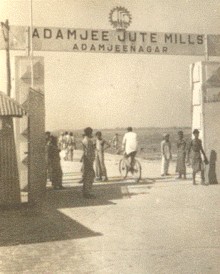Adamjee Jute Mills

Adamjee Jute Mills entrance (1950)
|
|
| Public | |
| Industry | Jute |
| Founded | 1951 |
| Founder | Abdul Wahid Adamjee |
| Headquarters | Narayanganj, Bangladesh |
| Products | Jute related products |
Adamjee Jute Mill was established in Narayanganj, Bangladesh, in 1951, by Adamjee Group, immediately after Bawa Jute Mills (the first jute mill in Bangladesh). Gradually, the mill became the largest jute mill in the world preceding the jute mills of Kolkata, India, and Dundee, Scotland.
Adamjee Jute Mills was set up by Abdul Wahid Adamjee, Pakistan's foremost industrialist, and scion of the wealthiest family in the country. Initially, the said project was a partnership between the Adamjees and the PICIC (the government’s industrial arm). The Adamjee family, however, soon took control of the project, and eventually built it into the largest jute mill in the world. At the time of partition of Bengal in 1947, there were 108 jute mills in Bengal but all of them fell to the share of India. The government of Pakistan encouraged Muslim entrepreneurs to come forward with proposals for establishment of jute mills in the country, following which Adamjee Brothers of calcutta agreed to act as a promoter and presented an investment plan in December 1949. In line with its proposal, Adamjee Brothers contributed 50% of the share capital while the Pakistan Industrial Development Corporation (PIDC) sanctioned the rest of the capital. The proposed site for the new mill was Siddhirganj, about six kilometres north of Narayanganj, which had good river, road and rail communication facilities. Two hundred twenty seven acres of land was acquired and developed for the construction of the mill. PIDC arranged for import of machinery and equipment for the mill with government grants of foreign exchange and by June 1955, the mill was ready for commissioning and had 3000 looms and 31200 spindles. The production capacity of the mill was 117 ton of twist and yarn, 953 ton of hessian and 4006 ton of sacking bag. The Adamjee family lost control of the mill in 1971 during the Bangladesh Liberation War. It employed over 26,000 workers at its height.
Adamjee Jute Mills was established to utilize the relatively finer jute fibers of the Bangladesh (East Pakistan of that time) region. Narayanganj was the largest or second largest jute market of the world. As there are many rivers and was a gateway to Dhaka, Narayanganj's economic activities were largely contributed by Adamjee Jute Mills and it was also called the Dundee of the East.
...
Wikipedia
